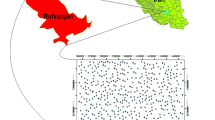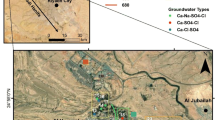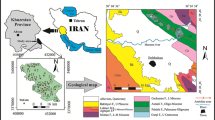Abstract
Agricultural activities are often associated with contamination of water, which resulted in high concentration of nutrients and trace metals in the shallow aquifer. Occurrence and distribution of nutrients and trace metals in the groundwater of intensively irrigated region of Luvuvhu catchment were carried out to determine the status of groundwater quality and its suitability for drinking. Groundwater samples were collected and analysed for physio-chemical parameters. The results suggest that the concentration of nutrients and trace metals in the groundwater are below the permissible limit of drinking water standards recommended by the World Health Organization and South African standards except pH, K, and Pb. Low pH (51%), potassium (31%), and lead (100%) restrict the groundwater usage for drinking. Relation between groundwater flow direction and EC, sulphate, nitrate, and ammonium contents indicate that it is mostly constant towards the center of the study area, but sudden enrichment is noticed in the downstream. Silica and fluoride have increased along with the direction of groundwater flow. Trace metals (B, Pb, and Zn) show decreasing trend in the flow direction. However, pH, K, Li, Cr, and phosphate concentrations do not show significant variation along the flow direction. Positive relation between nitrate, EC, sulphate, and ammonium implies that groundwater quality is affected by the surface contamination sources, and mostly from irrigation return flow, through the application of fertilizers and organic manures. However, groundwater with high silica and fluoride also has high nitrate, which justify that wastewater infiltration from surface has triggered the mineral dissolution in the vadose. Trace metals does not correlate with nitrate. High concentrations of trace metals are recorded with low nitrate, which implies that metals are derived from mineral weathering. However, boron concentrations in few wells show positive relation with nitrate, which justified the impact of natural sources and irrigational activities.








Similar content being viewed by others
References
Ağca N, Karanlık S, Ödemiş B (2014) Assessment of AMMONIUM, nitrate, Phosphate, and heavy metal pollution in groundwater from Amik Plain, southern Turkey. Environ Monit Assess 186:5921–5934. https://doi.org/10.1007/s10661-014-3829-z
Almodaresi SA, Mohammadrezaei M, Dolatabadi M, Nateghi MR (2019) Qualitative analysis of groundwater quality indicators based on schuler and WILCOX diagrams: IDW and kriging models. J Environ Health Sustain Dev. https://doi.org/10.18502/jehsd.v4i4.2023
American Public Health Association (APHA) (2005) Standard methods for examination of water and wastewater, 21st edn. American Public Health Association, Washington, DC
Atikul Islam M, Zahid A, Rahman MM et al (2016) Investigation of groundwater quality and its suitability for drinking and agricultural use in the South central part of the coastal region in Bangladesh. Exposure Health 9:27–41. https://doi.org/10.1007/s12403-016-0220-z
Barzegar R, Asghari Moghaddam A, Soltani S et al (2017) Heavy Metal(loid)s in the Groundwater of SHABESTAR AREA (NW Iran): Source identification and health risk assessment. Exposure Health 11:251–265. https://doi.org/10.1007/s12403-017-0267-5
Basahi JM, Masoud MHZ, Rajmohan N (2018) Effect of flash flood on trace metal pollution in the groundwater - WADI Baysh BASIN, western Saudi Arabia. J Afr Earth Sci 147:338–351. https://doi.org/10.1016/j.jafrearsci.2018.06.032
Busico G, Kazakis N, Colombani N et al (2017) A modified SINTACS method for Groundwater vulnerability and pollution risk assessment in highly Anthropized regions based on No3− AND SO42− concentrations. Sci Total Environ 609:1512–1523. https://doi.org/10.1016/j.scitotenv.2017.07.257
Chenini I, Khemiri S (2009) Evaluation of ground water quality using multiple linear regression and structural equation modeling. Int J Environ Sci Technol 6:509–519. https://doi.org/10.1007/bf03326090
Chidambaram S, Sarathidasan J, Srinivasamoorthy K et al (2018) Assessment of hydrogeochemical status of groundwater in a coastal region of southeast coast of India. Appl Water Sci. https://doi.org/10.1007/s13201-018-0649-2
Chotpantarat S, Parkchai T, Wisitthammasri W (2020) Multivariate statistical analysis of hydrochemical data and stable isotopes of groundwater contaminated with nitrate AT Huay Sai Royal Development Study center and adjacent areas IN PHETCHABURI Province. Thailand Water 12:1127. https://doi.org/10.3390/w12041127
Department of water affairs. (2010). Groundwater- A resource more valuable than gold. Gwd.org.za/book/export/html/262.
Durowoju OS, Odiyo JO, Ekosse GIE (2016) Variations of heavy metals from geothermal spring to surrounding soil and Mangifera indica-Siloam village. Limpopo Province Sustain (switzerland) 8(1):1–12. https://doi.org/10.3390/su8010060
Edet A (2014) Baseline concentration and sources of trace elements in Groundwater of Cross River State, Nigeria. Int J Environ Monit Anal 2:1. https://doi.org/10.11648/j.ijema.20140201.11
Fadiran AO, Dlamini SC, Mavuso A (2008) A comparative study of the phosphate levels in some surface and ground water bodiesof swaziland. Bull Chem Soc Ethiop. https://doi.org/10.4314/bcse.v22i2.61286
Heydarirad L, Mosaferi M, Pourakbar M, et al (2019) Groundwater salinity and quality assessment using multivariate statistical And HYDROGEOCHEMICAL analysis along the URMIA lake coastal IN azarshahr Plain, North west of Iran. Environ Earth Sci. https://doi.org/10.1007/s12665-019-8655-8
Jinwal A, Dixit S, Malik S (2010) Some trace Elements investigation in ground water of Bhopal & Sehore district in Madhya Pradesh: India. J Appl Sci Environ Manag. https://doi.org/10.4314/jasem.v13i4.55406
Khan MN, Mobin M, Abbas ZK, Alamri SA (2018) Fertilizers and their contaminants in soils, surface and groundwater. Encyclop Anthropocene. https://doi.org/10.1016/b978-0-12-809665-9.09888-8
Kumar A, Singh CK (2020) Arsenic enrichment in groundwater and associated health risk in Bari doab region of Indus basin, Punjab, India. Environ Pollut 256:113324. https://doi.org/10.1016/j.envpol.2019.113324
Lawniczak AE, Zbierska J, Nowak B et al (2016) Impact of agriculture and land use on Nitrate contamination in groundwater and running waters in central-west poland. Environ Monit Assess. https://doi.org/10.1007/s10661-016-5167-9
Li P, Qian H, Wu J, Chen J, Zhang Y, Zhang H (2014) Occurrence and hydrogeochemistry of fluoride in alluvial aquifer of Weihe River, China. Environ Earth Sci 71(7):3133–3145. https://doi.org/10.1007/s12665-013-2691-6
Lwimbo K, Muzuka, (2019) Impacts of EMERGING agricultural practices on groundwater quality in Kahe Catchment. Tanzania Water 11:2263. https://doi.org/10.3390/w11112263
Mabilde L, De Neve S, Sleutel S (2017) Regional analysis of groundwater phosphate concentrations under acidic sandy soils: Edaphic factors and water table strongly mediate the soil p-groundwater p relation. J Environ Manag 203:429–438. https://doi.org/10.1016/j.jenvman.2017.07.058
Magesh NS, Chandrasekar N, Elango L (2017) Trace element concentrations in the Groundwater of the tamiraparani river BASIN, South INDIA: Insights from human health risk and multivariate statistical techniques. Chemosphere 185:468–479. https://doi.org/10.1016/j.chemosphere.2017.07.044
Mahvi AH, Nouri J, Babaei AA, Nabizadeh R (2005) Agricultural activities impact on groundwater nitrate pollution. Int J Environ Sci Technol 2:41–47. https://doi.org/10.1007/bf03325856
Mosase E, Ahiablame L (2018) Rainfall and temperature in the Limpopo river BASIN, Southern AFRICA: MEANS, variations, and trends from 1979 to 2013. Water 10:364. https://doi.org/10.3390/w10040364
Mthembu PP, Elumalai V, Brindha K, Li P (2020) Hydrogeochemical processes and Trace metal contamination in groundwater: Impact on human health in the Maputaland Coastal Aquifer, South Africa. Exposure Health 12:403–426. https://doi.org/10.1007/s12403-020-00369-2
Mthembu PP, Elumalai V, Senthilkumar M, Wu J (2021) Investigation of Geochemical characterization and groundwater quality with special emphasis on health risk assessment in ALLUVIAL Aquifers, South Africa. International Journal of Environ Sci Technol. https://doi.org/10.1007/s13762-021-03129-0
Munyangane P, Mouri H, Kramers J (2016) Assessment of some potential harmful trace elements (PHTEs) in the borehole water of Greater Giyani, Limpopo Province, South Africa: possible implications for human health. Environ Geochem Health 39(5):1201–1219. https://doi.org/10.1007/s10653-016-9887-0
Nethononda VG, Elumalai V, Rajmohan N (2019) Irrigation return FLOW induced Mineral weathering and ion exchange reactions in the AQUIFER, Luvuvhu CATCHMENT, South Africa. J Afr Earth Sc 149:517–528. https://doi.org/10.1016/j.jafrearsci.2018.09.001
Nolan BT (2001) Relating nitrogen sources and Aquifer susceptibility to nitrate in shallow GROUND waters of the United States. Ground Water 39:290–299. https://doi.org/10.1111/j.1745-6584.2001.tb02311.x
Ogbozige FJ, Adie DB, Abubakar UA (2018) Water quality assessment and mapping using inverse distance weighted INTERPOLATION: A case of River Kaduna. Nigeria Nigerian J Technol 37:249. https://doi.org/10.4314/njt.v37i1.33
Oren O, Yechieli Y, Böhlke JK, Dody A (2004) Contamination of GROUNDWATER under cultivated fields in an arid environment, Central Arava Valley, Israel. J Hydrol 290:312–328. https://doi.org/10.1016/j.jhydrol.2003.12.016
Rajmohan N, Patel N, Singh G, Amarasinghe U (2017) Hydrochemical evaluation and identification of geochemical processes in the shallow and deep wells in the Ramganga Sub-Basin. India Environ Sci Pollut Res 24(26):21459–21475
Rajmohan, N. (2020). Groundwater Contamination Issues in the Shallow Aquifer, Ramganga Sub-basin, India. In: Kumar M., Snow D., Honda R. (eds) Emerging Issues in the Water Environment during Anthropocene. Springer Transactions in Civil and Environmental Engineering. Springer, Singapore, pp 337–354. https://doi.org/10.1007/978-981-32-9771-5_18
Rakib MA, Sasaki J, Matsuda H et al (2020) Groundwater salinization and associated co-contamination risk increase severe drinking water vulnerabilities in the southwestern coast of Bangladesh. Chemosphere 246:125646. https://doi.org/10.1016/j.chemosphere.2019.125646
Roering C, van Reenen DD, Smit CA et al (1992) Tectonic model for the evolution of the LIMPOPO BELT. Precambr Res 55:539–552. https://doi.org/10.1016/0301-9268(92)90044-o
Shepard D (1968) A two-dimensional interpolation function for irregularly-spaced data. In: Proceedings of the 1968 ACM National Conference, pp 517–524
Shobha BS (2018) A comprehensive assessment of spatial interpolation method using IDW technique for the groundwater quality evaluation of an industrial area in Bangalore, India. Am J Civ Environ Eng 3(4), 2018, pp. 68–82.
Singh A (2013) Nitrate and phosphate contamination in water and possible remedial measures. Environmental Problems and Plant, February 2013, 44–56.
Soil classification working group. (1991). Soil classification – a taxonomic system for South Africa. Department of agricultural development, Pretoria, South Africa.
Stigter TY, van Ooijen SPJ, Post VEA et al (1998) A hydrogeological and HYDROCHEMICAL explanation of the groundwater composition UNDER irrigated land in a Mediterranean environment, ALGARVE, PORTUGAL. J Hydrol 208:262–279. https://doi.org/10.1016/s0022-1694(98)00168-1
Tiwari RN, Mishra S, Pandey P (2013) Study of major and trace elements in groundwater of Birsinghpur area, Satna District Madhya Pradesh, India. International Journal of Water Resources and Environmental Engineering 5(7):380–386
Vetrimurugan E, Elango L (2014) Groundwater chemistry and quality in an Intensively Cultivated River Delta. Water Qual Expo Health 7:125–141. https://doi.org/10.1007/s12403-014-0133-7
Vetrimurugan E, Elango L, Rajmohan N (2013) Sources of contaminants and groundwater quality in the coastal part of a river delta. Int J Environ Sci Technol 10:473–486. https://doi.org/10.1007/s13762-012-0138-3
Vetrimurugan E, Brindha K, Elango L, Ndwandwe OM (2016) Human exposure risk to heavy metals through groundwater used for drinking in an intensively irrigated river delta. Appl Water Sci 7:3267–3280. https://doi.org/10.1007/s13201-016-0472-6
Vetrimurugan E, Brindha K, Elango L (2017) Regional and temporal variation in minor ions in groundwater of a part of a large river delta, southern India. Environ Monit Assess. https://doi.org/10.1007/s10661-017-6006-3
Wagh VM, Panaskar DB, Mukate SV et al (2018) Health risk assessment of heavy metal contamination in Groundwater of Kadava river Basin, Nashik, India. Model Earth Syst Environ 4:969–980. https://doi.org/10.1007/s40808-018-0496-z
World health organisation (2009). Potassium in drinking-water Background document for development of WHO Guidelines for Drinking-water Quality
World Health Organisation (2011). Guidelines for drinking water quality, fourth edition
Zhou Y, Ning J, Li L, Long Q, Wei A, Liu Z (2020) Health risk assessment of groundwater in Gaobeidian, North China : distribution, source, and chemical species of the main contaminants. Exposure Health 12(3):427–446. https://doi.org/10.1007/s12403-020-00365-6
Acknowledgements
Authors from the University of Zululand express their gratitude to National Research Foundation (NRF), South Africa (NRF/NSFC Reference: NSFC170331225349 Grant No: 110773) for providing grants and Department of Research and Innovation, the University of Zululand for their support in buying Ion Chromatography instrument for this research.
Author information
Authors and Affiliations
Corresponding author
Ethics declarations
Conflict of interest
The authors of this paper have no conflicts of interest to declare.
Additional information
Publisher's Note
Springer Nature remains neutral with regard to jurisdictional claims in published maps and institutional affiliations.
This article is part of a Topical Collection in Environmental Earth Sciences on Groundwater quality and contamination and the application of GIS, guest edited by Narsimha Adimalla and Hui Qian.
Rights and permissions
About this article
Cite this article
Patience, M.T., Elumalai, V., Rajmohan, N. et al. Occurrence and distribution of nutrients and trace metals in groundwater in an intensively irrigated region, Luvuvhu catchment, South Africa. Environ Earth Sci 80, 752 (2021). https://doi.org/10.1007/s12665-021-10021-0
Received:
Accepted:
Published:
DOI: https://doi.org/10.1007/s12665-021-10021-0




